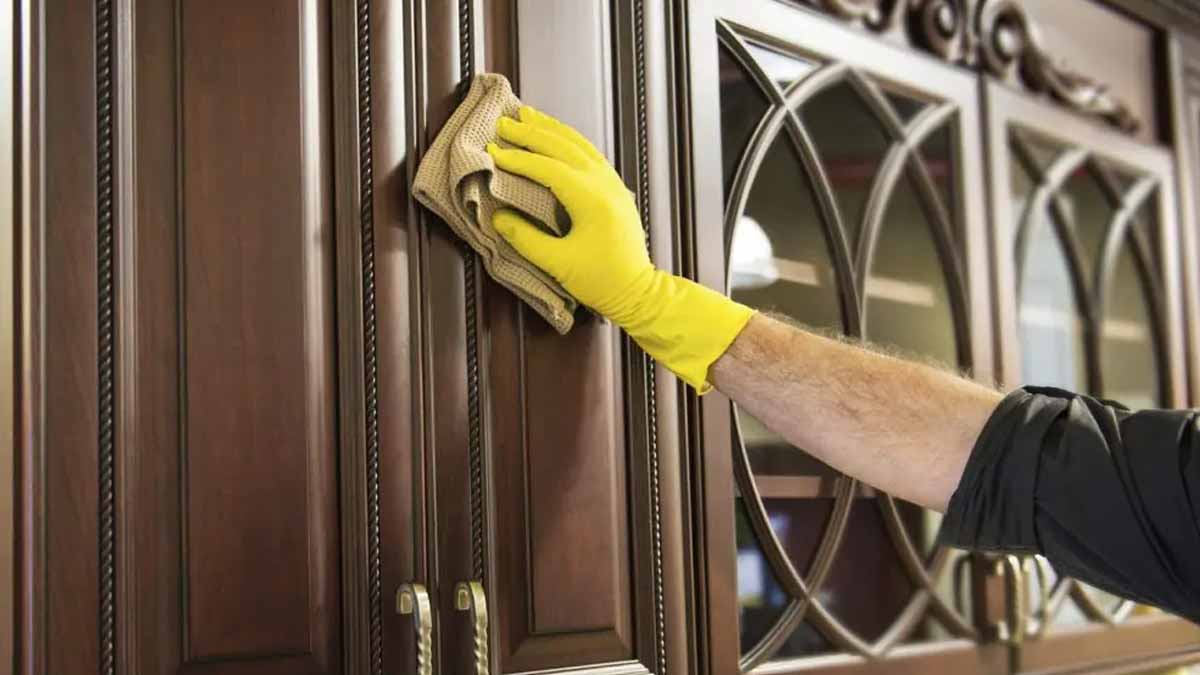A clean kitchen starts with surfaces that still glow after cooking. The trick is preserving the finish while lifting grime fast. Wood Cabinets look rich because their protective coats are thin and clear, so every gesture matters. Use light pressure, simple products, and steady habits. With the right order of steps, you remove grease, respect the finish, and bring back luster without risk or waste.
Why finishes on Wood Cabinets need gentle care
Safeguarding films encompass polyurethane, nitrocellulose finish, and, on certain antique items, resin coating. These applications measure merely the depth of several paper layers, so vigorous rubbing may damage them. According to furniture maker Chris Marshall, that damage is hard for homeowners to repair well, which is why a careful routine matters.
Daily life marks doors and drawers with fingerprints, grease spatter, food stains, pet scratches, and oily dust. Humid bathrooms, smoke, sun, and oxidation can add haze and discoloration. Marshall notes the biggest culprits are greasy buildup and fingerprints that glue dust to surfaces. Because of this mix, plan gradual cleaning that lifts grime while avoiding abrasion or swelling.
Begin with moisture-free particle elimination. A suction device featuring a bristle-tipped fabric attachment or narrow implement extracts scattered material without creating floating particles. You may alternatively manual-clean using a gentle textile lightly sprayed with wood conditioner, or a minimally moistened fabric. Apply delicately so particles rise rather than streak, then transition to liquid sanitization only where necessary.
Routine dusting and safe weekly wipe-downs
Frequency depends on use, cooking style, and general dust. Ron Shimek of Mr. Handyman in Waco, Texas, suggests cleaning as needed, which often means weekly in busy kitchens. Let the surface tell you; when it looks or feels grimy, it’s time. This flexible timing keeps work low while stopping buildup before it hardens.
Water control prevents swelling and spots. As Marshall says, a little water goes a long way. Dampen a clean sponge so it wets the surface without drips running down your arms. Wipe, then immediately dry with a microfiber cloth or soft towel. This quick handoff avoids halos and protects edges and seams.
Focus on limited areas: a compartment, a panel, a surface. Sanitize it, remove moisture, then progress forward. Always start at the top so dust and moisture don’t fall onto finished areas. Include face frames and undersides of rails. This steady top-to-bottom pattern builds speed because you never backtrack, and results stay consistent across the kitchen.
Deep degreasing with soap first, vinegar only if needed
Begin with the mildest cleaner. Dish detergent diluted in warm water is enough for most grease, says Marshall. Suds a soft sponge, wet the surface, and rub gently. Let the surfactants break bonds between oil and finish. Do not scrub hard. Dry, then check with fingertips for any tacky residue left behind.
If you still feel slickness, add ¼ to ½ cup white vinegar to your soapy bucket. The mild acid helps cut stubborn oil. Test a hidden spot first, Shimek advises, since acidity can harm certain finishes. Avoid harsh degreasers like TSP, bathroom cleaners, ammonia, or bleach. They are too strong and can cloud or etch the coating.
Knobs and pulls clean well with the same sudsy water. For tarnished metal, use a dab of liquid or paste metal polish on a soft cloth. For grimy hinges, wipe with WD-40 on a cloth; it dissolves dried residue and helps prevent rust. A quick straw-tip spritz into the hinge knuckle also silences squeaks without mess.
Shine, wax, and what polishes really do
Use products that match the finish. Some pieces respond to a tiny amount of mineral oil, which can refresh tone and add glow, notes Shimek. Still, Marshall prefers soap and water because many polishes rely on petroleum solvents. They look glossy at first yet don’t protect the coating in a meaningful way over time.
Paste wax, such as Liberon Black Bison Fine Paste Wax, gives longer-lasting shine, like waxing a car. It takes more effort but resists fingerprints better than light spray polishes. Apply thin, then buff when dry. Be patient between coats. This slower method rewards you with a clearer sheen and less frequent touch-ups.
Be cautious with silicone products. Silicone can seep into micro-cracks you can’t see and later block new finishes from bonding, Marshall warns. If you ever plan to strip to bare wood and refinish, that residue is stubborn. Mineral oil can also attract dust if left heavy, so always buff until the surface feels dry to the touch.
Hardware, hinges, and mistakes that quietly ruin Wood Cabinets
DIY mixes have tradeoffs. Vinegar is an effective degreaser, though the dill-pickle smell isn’t for everyone; wear gloves, eye protection, and ventilate. Olive oil loosens organic grime but leaves residue that attracts dust and doesn’t improve protection. Remember, you’re cleaning the thin finish layer, not the timber underneath.
Dish soap diluted in water remains the gentle, economical go-to. Murphy’s Oil Soap is a mild store-bought option with many fans. Some liquid and aerosol polishes clean because their solvents lift grease; use sparingly to avoid buildup. Keep your kit simple: microfiber cloths, a soft brush, mild soap, and patience.
Prevent excessive moisture. Surplus liquid may distort surfaces or fog coatings. Eliminate harsh materials like metal scrubbers, which diminish and mark. Never apply ammonia, chlorine, acetone, isopropyl or ethyl alcohol, solvent remover, petroleum fuel, appliance degreasers, powerful restroom chemicals, or grinding compounds. When unsafe for inhalation or direct skin contact, it proves overly potent for Timber Cabinetry.
Clean smarter to preserve luster and avoid costly refinishing
Shine that lasts comes from light hands, simple soaps, and prompt drying. Build a habit : dust first, wash gently, test vinegar only when grease resists, and finish with careful buffing. Match products to the finish and treat hardware with the same care. With this rhythm, Wood Cabinets keep their glow without risking the protective coat.
